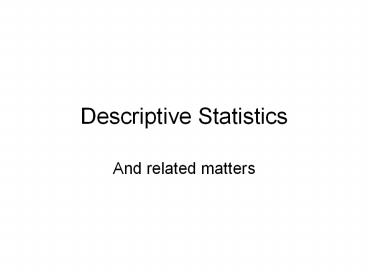Descriptive%20Statistics PowerPoint PPT Presentation
Title: Descriptive%20Statistics
1
Descriptive Statistics
- And related matters
2
Two families of statistics
- Descriptive statistics procedures for
summarizing, organizing, graphing, and, in
general, describing quantitative information - Mean, standard deviation, of items, etc.
- Inferential statistics statistics that allow
one to draw conclusions or inferences from the
data - ANOVA, t-test, correlation, etc.
Vogt, W. P. (1999). Dictionary of statistics
methodology (2nd ed.). Thousand Oaks, CA Sage
Publications.
3
Scales of measurement
- Nominal
- Used to name or categorize things
- Female 1,Male 2, correct 1,incorrect 0
- Often used for coding variables in research
- Ordinal
- Used to order things
- Gives relative position but not amount
- Rankings are ordinal
Shavelson, R. J. (1996). Statistical reasoning
for the behavioral sciences (Third ed.). Needham
Heights, MA Allyn Bacon.
4
Scales of measurement (2)
- Interval
- Each scale unit represents an equal distance of
the attribute being measured - Most test scores are considered interval scales
- Rating scales are often treated as interval
- Ratio
- Interval scales with a meaningful zero point
where zero indicates the absence of the attribute - examples weight, height, length
5
Scale summary
- Nominal scales categorize but do not order.
- Ordinal scales categorize and order.
- Interval scales categorize, order, and establish
an equal unit in the scale. - Ratio scales categorize, order, establish an
equal unit, and contain a true zero point.
Wiersma, W., Jurs, S. G. (1990). Educational
measurement and testing (2nd ed.). Needham
Heights, MA Allyn and Bacon, p. 13.
6
Frequency information
- Frequency distribution how many students
received each score - Cumulative frequency how many students scored
at or below the score in question - Cumulative percentage what percent of students
scored at or below the score in question - Useful for seeing patterns in the data
7
Output for SPSS
8
Measures of Central Tendency
- The four Ms
- Mean
- Mode
- Median
- Midpoint
9
Think about it
- Scores 18, 19, 20, 21, 87
- Which give a more accurate picture of this data,
the mean or the median? - Mean 33
- Median 20
- The median is usually more appropriate as a
measure of central tendency when there is an
outlier.
10
For a norm-referenced test
(Henning, 1987, p. 39)
11
Measures of Dispersion
- Range
- High score
- Low score
- Standard Deviation
- Variance
12
Conceptualizing variance
- Imagine a set of scores
- 8 10 13 9 7 11 10 12 10 9 11
- Picture those scores on a number line
Williams Monge (2001) Reasoning with statistics
13
Conceptualizing variance (2)
- Imagine those scores as deviations from the mean
(how far are they from the mean?)
14
Conceptualizing variance (3)
- Variance the mean of the squared deviation
scores about the mean of a distribution
15
Variance formula
16
Standard Deviation formula
17
(No Transcript)
18
The Normal Distribution
(Brown, 1996, p. 130)
19
Sample versus population
20
Describing distributions
Leptokurtic
Platykurtic
Think Leprechaun
Think Platypus
21
Skewed distributions
(Brown, 1996, p. 141)
22
Standardized scores
- A transformation of raw scores into a measure of
relative standing based on the mean and standard
deviation - Useful for comparing performance on tests of
different lengths, different forms, etc. - The most often used standardized scores are
z-scores, T-scores, and CEEB scores. - Relative standing is usually based on the norm
group (for a norm-referenced test)
23
Standard score comparison
(Brown, 1996, p. 135)
24
Practice
16 (15.9)
z (x m) / sd T 10z 50 CEEB 100z 500
82 (81.85)
A4. Ilianas z ? T? CEEB ?
5 (5.13)
100 (101.3)
1000 (1013)
About 5 (5.13)
25
Application exercises
Student Raw z-score T-score CEEB
A 64 70
B 50
C -1
D -1.5 350
2
700
50
500
0
40
400
43
39.5
35
Raw score mean 50, raw score standard deviation
7
26
Population and Sample
Population S1 S2 S3 S4 S5 S6 S7 S8 S9 S10
3 3 3 3 3 3
6 6 6 6 6 6 6
6 6 6 6 6 6
9 9 9 9 9
12 12 12 12 12 12 12
15 15 15 15 15 Average
Mean 8.5 5 12 7 7 10 10 7 9 8 8 8.3
SD(N) 4.03 1.41 2.45 3.74 1.41 5.10 3.74 3.74 2.45 5.10 2.83 3.20
SD(N-1) 1.73 3.00 4.58 1.73 6.24 4.58 4.58 3.00 6.24 3.46 3.92

